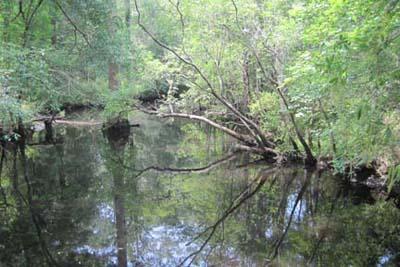Moores Creek National Battlefield in the sandhills of North Carolina is not close to other tourist attractions. I knew I was going in the right direction when I turned on General William Howe Highway. Howe was commander in chief of the British Forces during the American Revolution.
This quiet national park unit preserves the site of a short but important battle. The administrative history of Moores Creek says that the battle was to the Southern colonies what Lexington had been for the Northern colonies.
Moores Creek, 20 miles northwest of Wilmington, North Carolina, is a slow-moving blackwater creek. Cypress trees, with their characteristic knees, throw their reflection in the water. A bridge has stood there since 1743.
On February 26, 1776, the Patriots were given an ultimatum by the Loyalists. They could avoid combat if they laid down their arms and swore allegiance to the British Crown; the patriots refused. This set into motion a battle that had great consequences for the direction of the Revolutionary War.
Loyalists, Americans loyal to the British monarchy, marched to the coast and planned to join British forces under Lord Charles Cornwallis. To do that, they had to cross Moores Creek. This was the Patriots' last chance to stop them; they knew they couldn't win once the British Navy came after them. Col. James Moore of the 1st North Carolina Continentals took charge of countering the Loyalists.
That night the Patriots partly destroyed the bridge across Moores Creek. Then they abandoned their camps and hid in the earthworks they had previously built. Loyalists waited for daybreak then marched toward the earthworks where they were surprised with artillery fire.
The battle lasted about three minutes. Loyalists lost 30 men, the Patriots only one. This was the first Southern victory of the American Revolution, which ended British rule in the colony and can be considered a civil war. As a result, many believe North Carolina was the first colony to call for independence. The Patriot victory encouraged revolutionary fervor and helped beat back the British on Sullivan Island off the coast of Charleston, South Carolina.
Today, Moores Creek National Battlefield is an 88-acre park with two short trails, perfect for families willing to take a detour.
Stop in the visitor center and you'll find four panels that depict troop movements through the area; blue lights for patriots, and red lights for loyalists. Other panels depict a timeline in two parts. Above the line, events focus on national events dealing with the Revolutionary War. It starts with the stamp act on March 22, 1765, a direct tax on colonists.
Below the line are relevant North Carolina events. Gov. William Tryon, who was North Carolina's first Royal Governor (1767 to 1770), and who imposed taxes on liquor to fund Tryon Palace in New Bern. A display case has muskets, pistols, and broadswords of the day. The 12-minute film at the visitor center depicts the skirmish.
The History Trail, a one-mile loop, takes visitors to the battle site through savannah and swamp land. (Part of the trail is made out of recycled rubber that looks like wood chips that have been glued together.) Visitors pass six memorials, including one for Private John Grady, the only Patriot to be killed in this battle. A memorial to the Loyalists sits under a spreading oak tree with Spanish moss dripping from its branches. The earthworks have been rehabilitated to help visitors understand the battle.
The trail crosses the historic Negro Head Point Road, which linked the interior of North Carolina to the coast. This road was an important part of the slave trade. You can get a feel for colonial transportation by walking a small piece of the trail as it crosses the park.
A second trail, the Tarheel Trail, a third-of-a-mile long, goes through a stand of longleaf pine. Longleaf pines were tapped to make tar, rosins, pitch, and turpentine. These products, known as naval stores, were sent out to the port of Wilmington and the world to support the ship-building economy. The tar waterproofed the riggings of ships. Thousands of tar kilns were scattered throughout coastal plains and there's an example of a tar kiln on the trail. North Carolina is called the Tarheel state because of this history.
Once steel ships came in and these naval products were no longer needed, longleaf pines were cut down throughout the area and faster growing loblolly pines were planted in their place. The Park now has a program to plant longleaf pines throughout the site.
Protection of the site started formally on February 27, 1856, the 80th anniversary of the battle and when the first memorial was erected. The Moores Creek Monument Association founded in 1899 protected the battlefield until 1926, when it was turned over to the U.S. War Department. The National Park Service then acquired all battlefields in 1933.
[url=http://www.nps.gov/mocr/supportyourpark/joinourfriends.htm]
Moores Creek National Battlefield Association[/url] now has the distinction of being the oldest continuing operating Friends group in the National Park Service.




Add comment